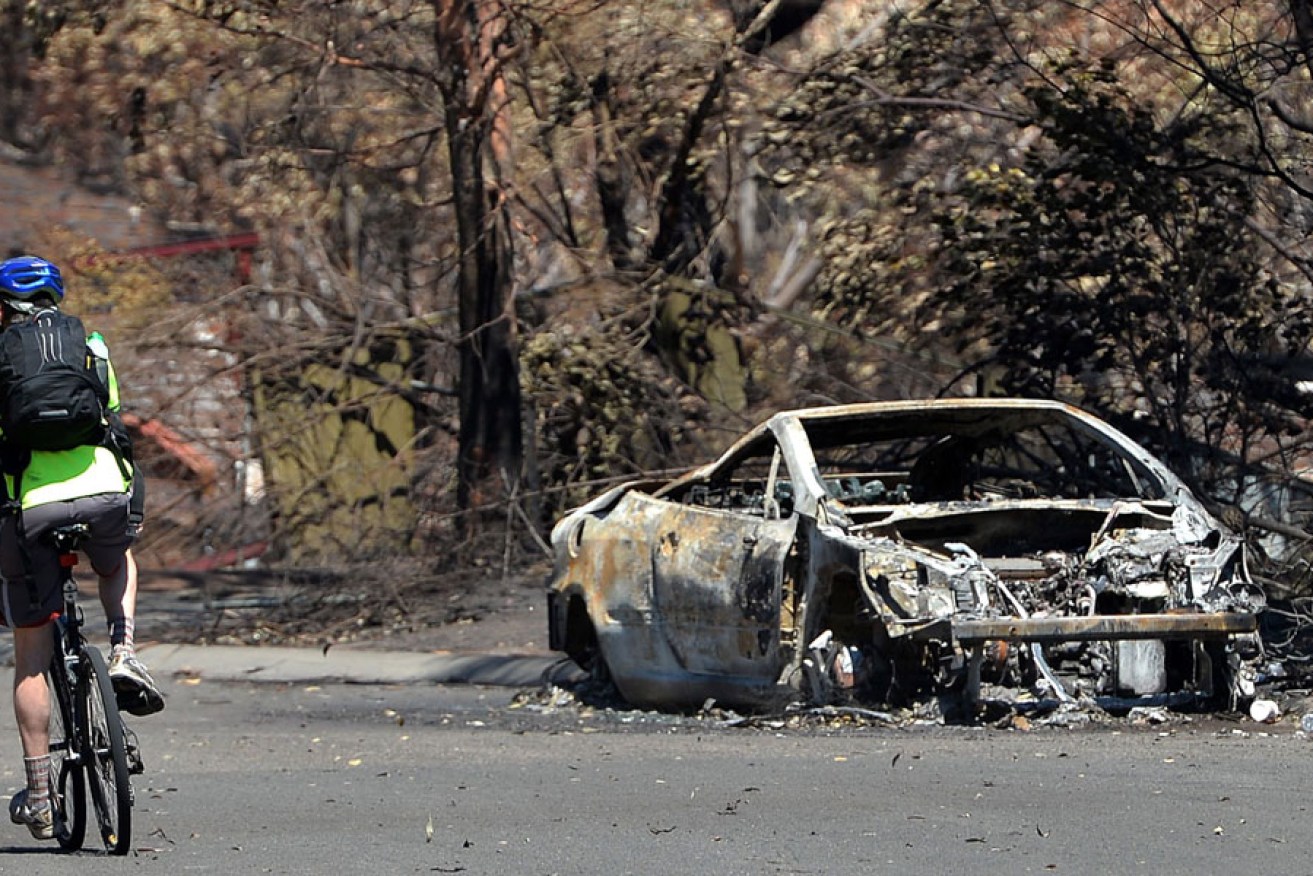Bushfires: Rural residents the solution, not the problem

A cyclist passes a car burnt out by bushfires in Springwood in the Blue Mountains last year.
The return of heatwaves and bushfires to the news pages has brought fresh warnings that Australians who live in fire-prone zones still don’t fully understand the risk they are running.
Deadly fires in Victoria’s Grampians and the Perth Hills, and the many other emergencies in South Australia and other states, have once again brought the dangers into stark relief. Yet we have found evidence that people living near bushland are more aware of the risks and remedies than they are given credit for.
Last October’s fires in New South Wales prompted a resurgence of debate about how to safeguard lives and homes. On one side are those who call for landscape-scale fuel-reduction burns, with government-mandated minimum areas to be burned each year.
On the other side are those who argue that resources are best devoted to preparing houses and their owners. This raises the question of how residents living near bushland will react to hazard-reduction strategies such as removing or thinning the trees they have chosen to live among.
Locals or liabilities?
Over 2013 my team has been interviewing people living near bushland in the Blue Mountains (mainly in Mount Wilson and Bilpin, north of the Grose Valley). We asked them why they live in these places, what they value in the landscape, where they perceive bushfire risk, and what they do about reconciling the things they like and things they worry about.
I have been talking to people like these for some years now. Most are “tree-changers”, second-home owners, or hobby farmers. They are commonly seen by land managers as a problem, because bushfire preparedness has often been low in areas where residential or semi-rural land abuts large areas of bushland or forest.
Our work is part of a larger project looking at the risk factors in property loss during bushfires. My colleague Ross Bradstock and his team have already found evidence (see here and here) that the most effective risk reduction is undertaken in and around properties.
Their work suggests that landscape-scale burning is less cost-effective in reducing risk to property than treatment that is focused within just 1-2 km of homes. In turn, this raises the question of whether residents are ready for the responsibility they must bear.
Risk and reward
Although my team has not yet finished analysing the data from our survey of residents, we have been impressed by their knowledge of how to meet the threat of bushfire. In the Blue Mountains, where the risk of fire from the large areas of national park is hard to miss, most of our interviewees understand the risks. They know where fires are likely to come from, and where their property stands in relation to this. In Mount Wilson, for example, residents were aware of how fire can move around and up to this area of higher land and where the threats to their property were likely to come from.
We also found that most people know there are limits to the effectiveness of any protective measures that can be undertaken at the landscape scale, and they focus on what can be done on and around their own property.
Many of the residents we interviewed are involved in local Rural Fire Service brigades that manage fire trails and vegetation. These activities spread local knowledge, teaching new residents about the particular quirks of the local landscape and how they influence fire behaviour.
Our findings seem to show that although residents in the Blue Mountains value their World Heritage-listed views, their nearby bushland and gorges, and the aesthetic and physical enjoyment offered by their gardens, this no longer necessarily comes at the expense of fire preparedness.
Many of our interviewees structure and shape these environments in ways that meet these values while also creating spaces that have a good chance of being defendable in the case of fire. While residents were perhaps fortunate in October with the winds that eventuated at key moments, we spoke to people who saw at first hand that their strategies were successful in the recent fires.
Changing attitudes
Our analysis may yet prove me wrong, but given the well-documented low levels of preparedness for fire in Australia and overseas, I have been surprised at the extent to which our interviewees were managing their homes and environments for fire. What is influencing this? It’s hard for me to say but it is possible that the 2009 Black Saturday fires in Victoria have spurred people to greater awareness and action. Such events often do, and these fires were often mentioned by our interviewees. They also often referred to the local Rural Fire Service Brigades whose volunteer leaders undertake considerable engagement work with residents.
While they may leave the odd favourite tree and bear the risk, people are now making pragmatic decisions in which they blend risk reduction with creating the gardens, homes, and outlooks that they desire. This is not an easy job. The labour and costs involved are significant and an ongoing maintenance task.
What all this tells me is that there is potential for managing bushfire risk in areas such as the Blue Mountains by working on and around properties. One of the concerns driving our project is the acceptability of such activities. Will residents accept vegetation management such as thinning or burning on or around their properties? Would they tolerate the removal of favourite trees?
Undoubtedly there will always be some who will not accept this, but what our survey suggests is that residents are increasingly willing to strike a balance that will let them enjoy life in the bush while minimising the risk of tragedy.
Nicholas Gill is Associate Professor in Geography at the University of Wollongong.
This article was first published at The Conversation.




